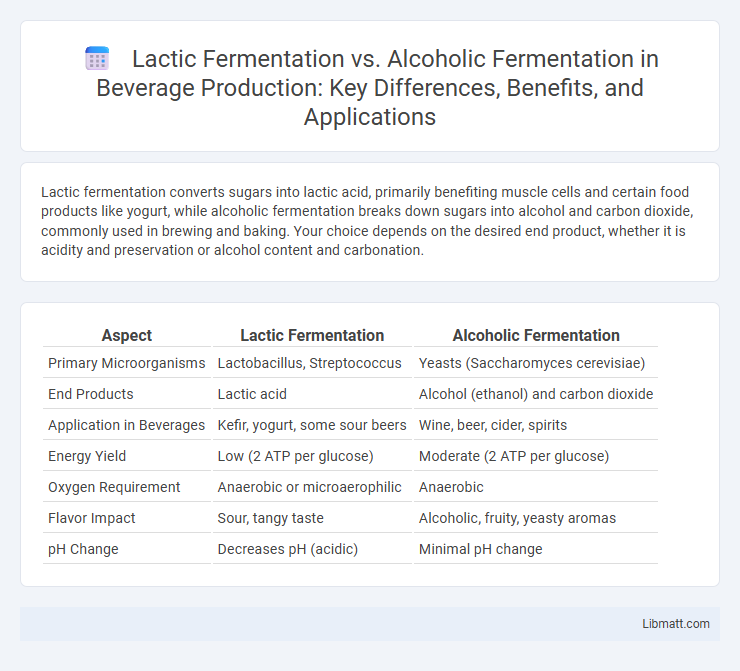Lactic fermentation converts sugars into lactic acid, primarily benefiting muscle cells and certain food products like yogurt, while alcoholic fermentation breaks down sugars into alcohol and carbon dioxide, commonly used in brewing and baking. Your choice depends on the desired end product, whether it is acidity and preservation or alcohol content and carbonation.
Table of Comparison
| Aspect | Lactic Fermentation | Alcoholic Fermentation |
|---|---|---|
| Primary Microorganisms | Lactobacillus, Streptococcus | Yeasts (Saccharomyces cerevisiae) |
| End Products | Lactic acid | Alcohol (ethanol) and carbon dioxide |
| Application in Beverages | Kefir, yogurt, some sour beers | Wine, beer, cider, spirits |
| Energy Yield | Low (2 ATP per glucose) | Moderate (2 ATP per glucose) |
| Oxygen Requirement | Anaerobic or microaerophilic | Anaerobic |
| Flavor Impact | Sour, tangy taste | Alcoholic, fruity, yeasty aromas |
| pH Change | Decreases pH (acidic) | Minimal pH change |
Introduction to Fermentation Processes
Fermentation processes convert sugars into energy under anaerobic conditions, producing different end products based on the pathway. Lactic fermentation transforms glucose into lactic acid using lactic acid bacteria, essential for yogurt and sauerkraut production, while alcoholic fermentation converts sugars into ethanol and carbon dioxide via yeast, key in brewing and winemaking. Your choice between these fermentation types depends on the desired flavor profile, texture, and application in food or beverage production.
Definition of Lactic Fermentation
Lactic fermentation is a metabolic process where glucose is converted into cellular energy and the metabolite lactate, primarily by lactic acid bacteria. This anaerobic fermentation is commonly used in the production of yogurt, sauerkraut, and kimchi, preserving food while enhancing flavor and probiotic benefits. Understanding lactic fermentation can help you optimize food preservation or improve gut health through fermented products.
Definition of Alcoholic Fermentation
Alcoholic fermentation is a biological process where sugars such as glucose are converted by yeast or certain bacteria into ethanol and carbon dioxide, typically under anaerobic conditions. This fermentation type differs from lactic fermentation, which produces lactic acid instead of alcohol. Understanding alcoholic fermentation is crucial for industries like brewing, winemaking, and biofuel production to optimize your fermentation processes.
Key Microorganisms Involved
Lactic fermentation primarily involves lactic acid bacteria such as Lactobacillus, Streptococcus, and Leuconostoc species, which convert sugars into lactic acid, contributing to the sour taste and preservation of products like yogurt and sauerkraut. Alcoholic fermentation is driven by yeast species, notably Saccharomyces cerevisiae, that metabolize sugars into ethanol and carbon dioxide, essential for brewing beer, wine, and baking. Both fermentation types rely on distinct microorganisms that determine the end-products' biochemical composition and industrial applications.
Biochemical Pathways and Reactions
Lactic fermentation converts glucose into lactic acid through glycolysis followed by the reduction of pyruvate using lactate dehydrogenase, regenerating NAD+ for ATP production. Alcoholic fermentation transforms glucose into ethanol and carbon dioxide via glycolysis, with pyruvate decarboxylase converting pyruvate to acetaldehyde and alcohol dehydrogenase reducing acetaldehyde to ethanol, also regenerating NAD+. Your choice between these pathways depends on the desired end products and the specific enzymes catalyzing each step in these anaerobic processes.
Main End Products and By-Products
Lactic fermentation primarily produces lactic acid as its main end product, with no release of carbon dioxide, making it essential for products like yogurt and sauerkraut. Alcoholic fermentation results in ethanol and carbon dioxide as its main end products, commonly utilized in brewing and winemaking. Understanding these pathways helps you optimize fermentation processes based on desired end products and by-products.
Typical Examples and Applications
Lactic fermentation is commonly used in producing yogurt, sauerkraut, and kimchi, where lactic acid bacteria convert sugars into lactic acid, enhancing flavor and preserving the food. Alcoholic fermentation, driven by yeast such as Saccharomyces cerevisiae, is essential in brewing beer, winemaking, and baking by converting sugars into ethanol and carbon dioxide. Your choice between these fermentations depends on whether you want to achieve sour, tangy tastes with probiotic benefits or create alcoholic beverages and leavened bread.
Environmental Conditions Required
Lactic fermentation thrives in anaerobic environments with temperatures typically between 30degC and 40degC, favoring moderately warm and low-oxygen conditions. Alcoholic fermentation also requires anaerobic conditions but operates optimally at slightly higher temperatures, around 25degC to 35degC, depending on yeast strain. Both processes depend on oxygen-free settings to ensure efficient conversion of substrates into lactic acid or ethanol, respectively.
Health and Nutritional Impacts
Lactic fermentation enhances your gut health by increasing the presence of beneficial probiotics and improving digestion through the production of lactic acid, which also preserves vitamins and minerals in foods like yogurt and sauerkraut. Alcoholic fermentation produces ethanol and carbon dioxide, contributing to calorie content while offering limited probiotic benefits and potential negative effects on liver health when consumed excessively. Both fermentation types influence nutritional profiles differently, with lactic fermentation promoting nutrient bioavailability and immune support, and alcoholic fermentation primarily serving as a source of energy with fewer direct health benefits.
Comparison: Lactic vs Alcoholic Fermentation
Lactic fermentation converts glucose into lactic acid, primarily occurring in muscle cells and certain bacteria, while alcoholic fermentation transforms glucose into ethanol and carbon dioxide, mainly by yeast and some bacteria. You benefit from lactic fermentation in yogurt and sauerkraut production, which enhances probiotic content, whereas alcoholic fermentation is essential in brewing beer and making wine. Both processes are anaerobic but yield different end products that impact flavor, texture, and uses in food and beverage industries.
Lactic fermentation vs alcoholic fermentation Infographic

 libmatt.com
libmatt.com